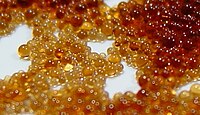
Photo from wikipedia
BACKGROUND Caffeic acid (CA) has anti-oxidation and anti-inflammatory. However, the poor hydrophilicity of CA limits its biological activities. In this work, hydrophilic glyceryl monocaffeate (GMC) was synthesized by the esterification… Click to show full abstract
BACKGROUND Caffeic acid (CA) has anti-oxidation and anti-inflammatory. However, the poor hydrophilicity of CA limits its biological activities. In this work, hydrophilic glyceryl monocaffeate (GMC) was synthesized by the esterification using different caffeoyl donors (deep eutectic solvent and solid CA). Some cation exchange resins were used as the catalysts. The effects of reaction conditions were also investigated. RESULTS The mass transfer limitation of the esterification was eliminated using deep eutectic solvent. Compared with the previous catalysts (immobilized lipase Novozym 435), an economic cation exchange resin Amberlyst-35 (A-35) showed a good catalytic performance for GMC preparation. The activation energies of GMC synthesis and CA conversion were 43.71 kJ mol-1 and 43.07 kJ mol-1 , respectively. The optimal reaction conditions were a temperature reaction of 90 °C, catalyst load of 7%, glycerol/CA molar ratio of 5:1 (mol/mol), and reaction time of 24 h, which resulted in the maximum GMC yield and CA conversion of 69.75 ± 1.03% and 82.23 ± 2.02%, respectively. CONCLUSION The results of the work showed a promising alternative for the synthesis of GMC. This article is protected by copyright. All rights reserved.
Journal Title: Journal of the science of food and agriculture
Year Published: 2023
Link to full text (if available)
Share on Social Media: Sign Up to like & get
recommendations!